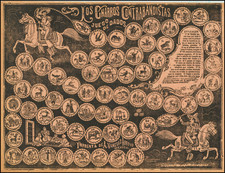An intricate and very rare 18th-century perpetual calendar.
A rare perpetual calendar of unusual design by the all-but unknown Parisian maker A. Duplessy (Duplessis). An amazing survival of a fragile paper instrument, and one of only two examples located.
The Gregorian calendar replaced the Julian calendar in France in 1582. The new calendar was constructed on complex mathematical principles which allowed those with the requisite skills to calculate forward important calendar events: days of the week (and their saint’s days), lengths of the day, months, phases of the moon, feast days and so on.
To aid those less mathematically adept, publishers produced a variety of clever instruments. The highly elaborate perpetual calendar offered here consists of a large engraved diagram mounted on a heavy pasteboard backing. The basic information is engraved in tables along the left and right side of the diagram on the face of the plate. These tables list, for each year between 1765 and 1864, the “epact” (a balancing number necessary to calculate the Easter celebrations, reconciling the Gregorian calendar and lunar calendar), the “golden number” (necessary for establishing full moons), “dominical letters: (used to calculate the day of the week from the start of the year) and the “grace days.”
The calculations were performed by means of separate letterpress sheets mounted on slides (“coulisses”). Each could be moved up and down and viewed through cutout windows in the main diagram in order to perform the required calculations. This calendar has three slides: months, saints’ days and moons (Indeed there are six slides for the saints’ days, each with tables for two months of the year. That all have survived, an in generally excellent condition, is a minor miracle.) At the base of the diagram is a lengthy explanation of the working of the calendar engraved at the bottom center. At the top of the two rotating circular dials, also viewed through cutouts, are to be used to calculate the moveable feasts—notably Easter—and the new moons.
The Calendrier Perpetuel is not dated, but given that the tables begin with 1765 it was probably published that year or the year prior. The instrument bears the notice that it was published “With the privilege of the King [i.e. an exclusive copyright] and the approbation of M. Cassini, Master of Accounts of the Royal Academy of Sciences.” The latter was astronomer and cartographer César-François Cassini de Thury, aka “Cassini III,” who among other things began the magnificent 180-sheet topographical map of France that was eventually finished by his son Jean-Dominique. Neither the nature of the Cassini-Duplessis relationship, nor the form of Cassini’s “approbation.”
It seems likely the instrument was a commercial failure, as it is today extraordinarily rare. Indeed, I have been able to locate but one other example, held at the Carnavalet Museum in Paris.
It is worth noting that in 1767 Duplessis published a pamphlet bearing the title Calendrier Perpetuel ou Almanach Journalier, the final page of which appears to refer to this instrument.
Almost nothing is known of A. Duplessis, who apparently designed, published and sold instruments at his premises by the Pont Notre Dame (He may also have been an engraver.) We can also attribute to him with 100 percent confidence the Calendrier Perpetuel, an instrument of similar style and construction published in 1764 or -65. In 1767 he published a small pamphlet, also titled Calendrier Perpetuel, the last page of which describes him as a seller of geographic materials, including:
“all kinds of geographic maps, both general and particular, methodical & elementary atlases of geography & history; the analytic table of France, a complete collection of maps by the best authors, plans of Paris of all sizes, as well as Versailles, Nancy, Wesel, fortified cities, maritime charts and boundaries of the Kingdom, &c. He also sells the map of France, raised by order of the King, under the direction of Mssr. Cassini…”
The Bibliotheque Nationale de France holds a Plan de Nancy published in 1766 by an A. Duplessis. The BNF catalog also has a biographical entry for an A. Duplessis, “auteur, éditeur, distributeur,” resident in 1792 at the rue de la Calandre, quartier du Paris. This Duplessis, possibly one and the same as ours, drew, engraved and published a number of allegorical and patriotic images during the French Revolutionary era.










![[ Academia Land ] Kaart van het Stichtsche Academie-Land [ Stichtsche Academy Land ]](https://storage.googleapis.com/raremaps/img/small/74913.jpg)
![(California Pictorial Lettersheet) [Manuscript letter on Lettersheet with Bird's-eye view of Stockton, California]](https://storage.googleapis.com/raremaps/img/small/97542.jpg)

![Comparative Size of Lakes and Islands [Great Lakes, Cuba, Formosa, Ireland, Sicily, Cyprus, Vancouver, Sandwich Islands, Puerto Rico, Corsica, Sardinia, Balearics, Malta, etc]](https://storage.googleapis.com/raremaps/img/small/92574.jpg)
![(American Revolution - East Florida - Tropical Medicine - Slavery) [Manuscript document from John Moultrie dated May 16, 1784] Thoughts that may be of use to my people and plantation in the Bahamas and orders that I beg may be obeyed](https://storage.googleapis.com/raremaps/img/small/86627.jpg)